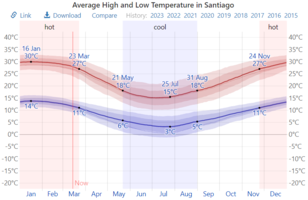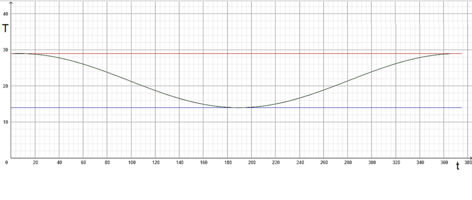Ok, I came across a sinusoidal problem involving finding a function that models temperature. It involved a a phase shift. What threw me was when it said that January 1st is t=1. What's that mean? What if it said regard that date as t=3, what does t= whatever imean for writing a function?
You are using an out of date browser. It may not display this or other websites correctly.
You should upgrade or use an alternative browser.
You should upgrade or use an alternative browser.
Understanding the meaing of a convention used for sinusoidal functions.
- Thread starter Befuddled
- Start date
Here's the specific question: So, if you could explain this t=x business, I'd be very grateful. So, show me what they mean and what would happen to the equation if you varied the count to any other integer, say t=3.
The daily average temperature in Santiago, Chile, varies over time in a periodic way that can be modeled approximately by a trigonometric function.
Assume the length of the year (which is the period of change) is exactly 365 days long. The hottest day of the year, on average, is January 7, when the average temperature is about 29ºC. The average temperature at the coolest day of the year is about 14ºC.
Find the formula of the trigonometric function that models the daily average temperature T in Santiago t days into the year. (t=1 equals January 1) Define the function using radians.
The daily average temperature in Santiago, Chile, varies over time in a periodic way that can be modeled approximately by a trigonometric function.
Assume the length of the year (which is the period of change) is exactly 365 days long. The hottest day of the year, on average, is January 7, when the average temperature is about 29ºC. The average temperature at the coolest day of the year is about 14ºC.
Find the formula of the trigonometric function that models the daily average temperature T in Santiago t days into the year. (t=1 equals January 1) Define the function using radians.
blamocur
Elite Member
- Joined
- Oct 30, 2021
- Messages
- 2,627
Looks like they want you to write a function [imath]T = a + b \sin (\omega t + \phi)[/imath], where you have to determine [imath]a,b,\omega, \phi[/imath].
They specify [imath]t=1[/imath] on January 1 because your function depends on where [imath]t[/imath] is counted from. I.e., if you replace, for example, variable [imath]t[/imath] with variable [imath]u[/imath] : [imath]u=t-7[/imath] (which means that [imath]u=1[/imath] on January 8) you would get an equivalent formula with different [imath]\phi[/imath]. Indeed, [imath]\sin(\omega t+\phi) = \sin (\omega u + \phi_2)[/imath] where [imath]\phi_2 = \phi + 7\omega[/imath].
They specify [imath]t=1[/imath] on January 1 because your function depends on where [imath]t[/imath] is counted from. I.e., if you replace, for example, variable [imath]t[/imath] with variable [imath]u[/imath] : [imath]u=t-7[/imath] (which means that [imath]u=1[/imath] on January 8) you would get an equivalent formula with different [imath]\phi[/imath]. Indeed, [imath]\sin(\omega t+\phi) = \sin (\omega u + \phi_2)[/imath] where [imath]\phi_2 = \phi + 7\omega[/imath].
Dr.Peterson
Elite Member
- Joined
- Nov 12, 2017
- Messages
- 16,087
Ok, I came across a sinusoidal problem involving finding a function that models temperature. It involved a a phase shift. What threw me was when it said that January 1st is t=1. What's that mean? What if it said regard that date as t=3, what does t= whatever i mean for writing a function?
The daily average temperature in Santiago, Chile, varies over time in a periodic way that can be modeled approximately by a trigonometric function.
Assume the length of the year (which is the period of change) is exactly 365 days long. The hottest day of the year, on average, is January 7, when the average temperature is about 29∘C. The average temperature at the coolest day of the year is about 14∘.
Find the formula of the trigonometric function that models the daily average temperature T in Santiago t days into the year. (t=1 on January 1) Define the function using radians.
You can arbitrarily choose any point as the origin for a function, in order to define the meaning of the input variable. They chose to define t=1 as meaning January 1 of a particular year, presumably because that made it easy to say what t equals on the hottest day.
(The choice of 0 degrees C as the freezing point of water is similarly arbitrary, if you think about it.)
There is nothing here beyond that. If you chose a different day to call t=1 or t=0, or chose to assign a different value of t to January 1, you would just be shifting your function, but not changing the meaning of any result you get. Convenience generally determines the choice.
The Highlander
Full Member
- Joined
- Feb 18, 2022
- Messages
- 937
Here is how temperature varies over a year in Santiago (from here)…Ok, I came across a sinusoidal problem involving finding a function that models temperature. It involved a a phase shift. What threw me was when it said that January 1st is t=1. What's that mean? What if it said regard that date as t=3, what does t= whatever imean for writing a function?
You are asked to come up with a sinusoidal function that "models" this variation (the red line) and that requires an expression of the form supplied to you by @blamocur (\(\displaystyle T = a + b \sin (\omega t + \phi)\)) that will produce a graph like this…
The variable “t” that you seem to be agonizing over is simply the day of the year, ie: t=1 is Jan 1st; t=7 is Jan 7th; t=31 is Jan 31st; t=32 is Feb 1st; t=365 is Dec 31st; and so on, plus “T” is the temperature reached on each of those days as indicated by your "model" (ie: the sinusoidal function you arrive at).
You can calculate the \(\displaystyle a, b \& \omega \) using the maximum & minimum temperatures provided (29 °C & 14 °C) and the period over which your function is to 'operate' (365 days equating to 2π), then, since you are given the temperature on Jan 7th (as 29 °C) ie: when t=7, you can insert that into what you have already constructed of the function to determine the phase shift (\(\displaystyle \phi\)).
If you are unsure as to how to go about doing all that then I suggest you study this webpage.
Last edited by a moderator:



